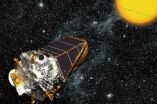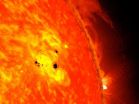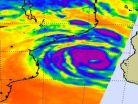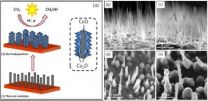(Press-News.org) AMES, Iowa – An international team of astronomers has used nearly three years of high precision data from NASA's Kepler spacecraft to make the first observations of a planet outside our solar system that's smaller than Mercury, the smallest planet orbiting our sun.
The planet is about the size of the Earth's moon. It is one of three planets orbiting a star designated Kepler-37 in the Cygnus-Lyra region of the Milky Way.
The findings are published were published online on Feb. 20 by the journal Nature. The lead authors are Thomas Barclay of the NASA Ames Research Center in California and the Bay Area Environmental Research Institute and Jason Rowe of NASA Ames and the SETI Institute in California.
Steve Kawaler, an Iowa State University professor of physics and astronomy, was part of a team of researchers who studied the oscillations of Kepler-37 to determine its size. "That's basically listening to the star by measuring sound waves," Kawaler said. "The bigger the star, the lower the frequency, or 'pitch' of its song."
The team determined Kepler-37's mass is about 80 percent the mass of our sun. That's the lowest mass star astronomers have been able to measure using oscillation data for an ordinary star.
Those measurements also allowed the main research team to more accurately measure the three planets orbiting Kepler-37, including the tiny Kepler-37b.
"Owing to its extremely small size, similar to that of the Earth's moon, and highly irradiated surface, Kepler-37b is very likely a rocky planet with no atmosphere or water, similar to Mercury," the astronomers wrote in a summary of their findings. "The detection of such a small planet shows for the first time that stellar systems host planets much smaller as well as much larger than anything we see in our own Solar System."
Kawaler said the discovery is exciting because of what it says about the Kepler Mission's capabilities to discover new planetary systems around other stars.
Kepler launched March 6, 2009, from Florida's Cape Canaveral Air Force Station. The spacecraft is orbiting the sun carrying a photometer, or light meter, to measure changes in the brightness of thousands of stars. Its primary job is to detect tiny variations in the brightness of the stars within its view to indicate planets passing in front of the star. Astronomers with the Kepler team are looking for earth-like planets that might be able to support life.
The Kepler Asteroseismic Investigation is also using data from that photometer to study stars. The investigation is led by a four-member steering committee: Kawaler, Chair Ron Gilliland of the Space Telescope Science Institute based in Baltimore, Jorgen Christensen-Dalsgaard and Hans Kjeldsen, both of Aarhus University in Denmark.
Kawaler said Kepler is sending astronomers photometry data that's "probably the best we'll see in our lifetimes." This latest discovery shows astronomers "we have a proven technology for finding small planets around other stars."
That could have implications for some big-picture discoveries: "While a sample of only one planet is too small to use for determination of occurrence rates," the astronomers write in the Nature paper, "it does lend weight to the belief that planet occurrence increases exponentially with decreasing planet size."
INFORMATION:
Contacts:
Steve Kawaler, Physics and Astronomy, 515-294-9728, sdk@iastate.edu
Mike Krapfl, News Service, 515-294-4917, mkrapfl@iastate.edu
Kepler spacecraft helps astronomers find tiny planet beyond our solar system
2013-02-21
ELSE PRESS RELEASES FROM THIS DATE:
Study shows long-term efficacy of minimally invasive therapy for patients with Barrett's esophagus
2013-02-21
Philadelphia - According to a new study by researchers at the Perelman School of Medicine at the University of Pennsylvania, patients with Barrett's esophagus and early or pre-cancerous cells have been shown to significantly benefit from minimally invasive therapy delivered through an endoscope – a medical instrument used to look inside an organ or cavity in the body. Until recently, patients with these conditions were treated by surgery to remove the whole esophagus. Study results show that endoscope-based therapies have a high success rate; all of the damaged cells were ...
Researchers identify variations in 4 genes associated with an increased risk of colorectal cancer
2013-02-21
SEATTLE – An international research team co-led by cancer prevention researcher Ulrike "Riki" Peters, Ph.D., M.P.H., and biostatistician Hsu Li, Ph.D., at Fred Hutchinson Cancer Research Center has identified variations in four genes that are linked to an increased risk of colorectal cancer. Peters and colleagues from 40 institutes throughout the world published their findings online ahead of the April print issue of Gastroenterology.
Peters and colleagues for the past four years have been studying the genes linked to colorectal cancer through the Genetics and Epidemiology ...
Prescription problems for vets on reflux drug
2013-02-21
CHICAGO --- U.S. veterans diagnosed with gastroesophageal reflux disease (GERD) are frequently prescribed doses of proton pump inhibitors (PPIs), such as omeprazole (commonly known by brand names such as Prilosec), that are much higher than recommended --- and they are kept on the drug far too long, according to a new Northwestern Medicine® study.
PPIs are among the most widely used drugs in the nation, resulting in more than $11 billion in annual direct health care costs in the U.S. PPI overuse has been documented in previous studies, but this is the first study to examine ...
NASA's SDO observes fast-growing sun spot
2013-02-21
As magnetic fields on the sun rearrange and realign, dark spots known as sunspots can appear on its surface. Over the course of Feb. 19-20, 2013, scientists watched a giant sunspot form in under 48 hours. It has grown to over six Earth diameters across but its full extent is hard to judge since the spot lies on a sphere not a flat disk.
The spot quickly evolved into what's called a delta region, in which the lighter areas around the sunspot, the penumbra, exhibit magnetic fields that point in the opposite direction of those fields in the center, dark area. This is a fairly ...
NASA's SDO shows a little rain on the sun
2013-02-21
VIDEO:
On July 19, 2012, an eruption occurred on the sun that produced a moderately powerful solar flare and a dazzling magnetic display known as coronal rain. Hot plasma in the...
Click here for more information.
Eruptive events on the sun can be wildly different. Some come just with a solar flare, some with an additional ejection of solar material called a coronal mass ejection (CME), and some with complex moving structures in association with changes in magnetic field lines ...
Regenstrief study: Informatics tools underutilized in prevention of hospital-acquired infection
2013-02-21
INDIANAPOLIS -- Advances in electronic medical record systems and health information exchange are shifting efforts in public health toward greater use of information systems to automate disease surveillance, but a study from the Regenstrief Institute has found that these technologies' capabilities are underutilized by those on the front lines of preventing and reporting infections.
The new study measured the awareness, adoption and use of electronic medical record systems and health information exchange by hospital-based infection preventionists (formerly known as infection ...
3 NASA satellites see wide-eyed Cyclone Haruna
2013-02-21
VIDEO:
The TRMM satellite flew above Haruna on Feb. 20 at 0717 UTC. Some powerful storms Haruna's northern edge showed rainfall over 108 mm (~4.25 inches) per hour and cloud tops...
Click here for more information.
Cyclone Haruna strengthened into a cyclone and quickly developed an eye that became apparent on visible and infrared imagery from NASA's Aqua satellite. NASA's TRMM satellite analyzed Haruna's heavy rainfall, and NASA and NOAA's Suomi NPP satellite captured a ...
Low-pitched song indicates fairy-wren size
2013-02-21
AUDIO:
This is an example of a trill song type that tells listeners how big the singer is. Their larger physical size means that bigger male purple-crowned fairy-wrens can sing this...
Click here for more information.
A male fairy-wren's low pitch song indicates body size, a new international study has shown.
The study led by University of Melbourne researcher Dr Michelle Hall, is the first to show that the larger the male fairy wren, the lower the pitch of his song.
"This ...
Genome-wide imaging study identifies new gene associated with Alzheimer's plaques
2013-02-21
INDIANAPOLIS -- A study combining genetic data with brain imaging, designed to identify genes associated with the amyloid plaque deposits found in Alzheimer's disease patients, has not only identified the APOE gene -- long associated with development of Alzheimer's -- but has uncovered an association with a second gene, called BCHE.
A national research team, led by scientists at the Indiana University School of Medicine, reported the results of the study in an article in Molecular Psychiatry posted online Tuesday. The study is believed to be the first genome-wide association ...
Researchers say sunlight yields more efficient carbon dioxide to methanol model
2013-02-21
Researchers from The University of Texas at Arlington are pioneering a new method for using carbon dioxide, or CO2, to make liquid methanol fuel by using copper oxide nanowires and sunlight.
The process is safer, simpler and less expensive than previous methods to convert the greenhouse gas associated with climate change to a useful product, said Krishnan Rajeshwar, interim associate vice president for research at UT Arlington and one of the authors of a paper recently published in the journal Chemical Communications. Researchers began by coating the walls of copper oxide, ...






